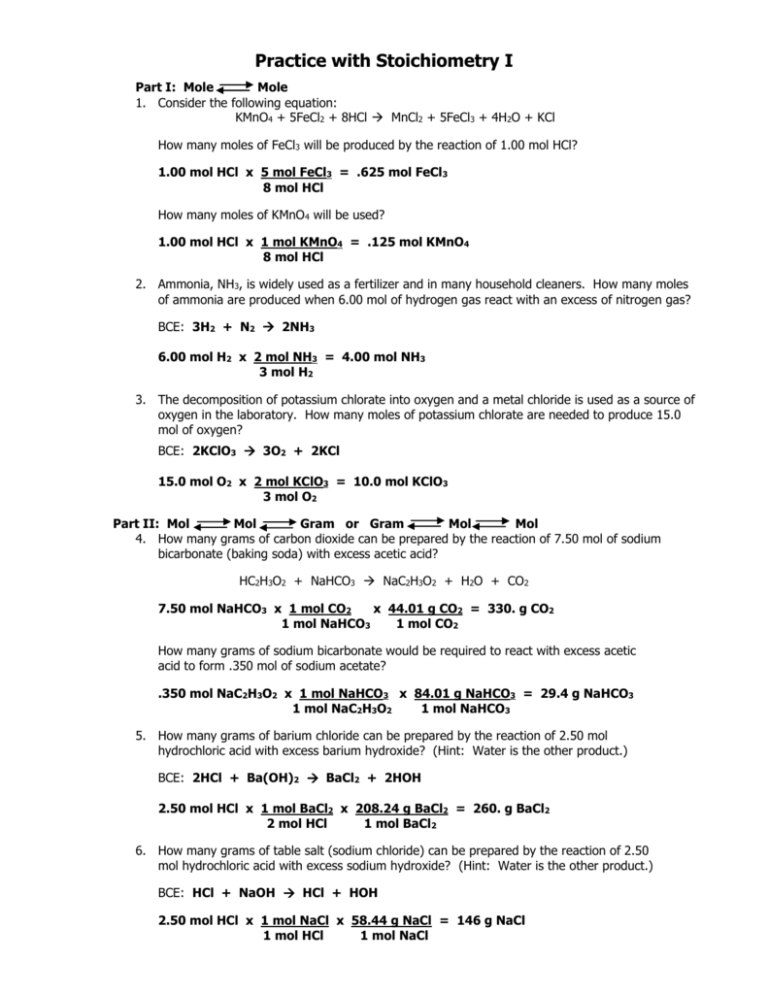Practice with Stoichiometry I
advertisement

Practice with Stoichiometry I Part I: Mole Mole 1. Consider the following equation: KMnO4 + 5FeCl2 + 8HCl MnCl2 + 5FeCl3 + 4H2O + KCl How many moles of FeCl3 will be produced by the reaction of 1.00 mol HCl? 1.00 mol HCl x 5 mol FeCl3 = .625 mol FeCl3 8 mol HCl How many moles of KMnO4 will be used? 1.00 mol HCl x 1 mol KMnO4 = .125 mol KMnO4 8 mol HCl 2. Ammonia, NH3, is widely used as a fertilizer and in many household cleaners. How many moles of ammonia are produced when 6.00 mol of hydrogen gas react with an excess of nitrogen gas? BCE: 3H2 + N2 2NH3 6.00 mol H2 x 2 mol NH3 = 4.00 mol NH3 3 mol H2 3. The decomposition of potassium chlorate into oxygen and a metal chloride is used as a source of oxygen in the laboratory. How many moles of potassium chlorate are needed to produce 15.0 mol of oxygen? BCE: 2KClO3 3O2 + 2KCl 15.0 mol O2 x 2 mol KClO3 = 10.0 mol KClO3 3 mol O2 Part II: Mol Mol Gram or Gram Mol Mol 4. How many grams of carbon dioxide can be prepared by the reaction of 7.50 mol of sodium bicarbonate (baking soda) with excess acetic acid? HC2H3O2 + NaHCO3 NaC2H3O2 + H2O + CO2 7.50 mol NaHCO3 x 1 mol CO2 x 44.01 g CO2 = 330. g CO2 1 mol NaHCO3 1 mol CO2 How many grams of sodium bicarbonate would be required to react with excess acetic acid to form .350 mol of sodium acetate? .350 mol NaC2H3O2 x 1 mol NaHCO3 x 84.01 g NaHCO3 = 29.4 g NaHCO3 1 mol NaC2H3O2 1 mol NaHCO3 5. How many grams of barium chloride can be prepared by the reaction of 2.50 mol hydrochloric acid with excess barium hydroxide? (Hint: Water is the other product.) BCE: 2HCl + Ba(OH)2 BaCl2 + 2HOH 2.50 mol HCl x 1 mol BaCl2 x 208.24 g BaCl2 = 260. g BaCl2 2 mol HCl 1 mol BaCl2 6. How many grams of table salt (sodium chloride) can be prepared by the reaction of 2.50 mol hydrochloric acid with excess sodium hydroxide? (Hint: Water is the other product.) BCE: HCl + NaOH HCl + HOH 2.50 mol HCl x 1 mol NaCl x 58.44 g NaCl = 146 g NaCl 1 mol HCl 1 mol NaCl Part III: Gram Mole Mole Gram 7. During cellular respiration, cells get energy from the combustion of glucose (C 6H12O6) in the presence of oxygen forming water and carbon dioxide as byproducts of the reaction. How many grams of water should be produced if 90.0 g of glucose is combusted? BCE: C6H12O6 + 6O2 CCO2 + 6H2O 90.0 g C6H12O6 x 1 mol C6H12O6 x 6 mol H2O x 18.02 g H2O = 54.0 g H2O 180.16 g C6H12O6 1 mol C6H12O6 1 mol H2O 8. The first step in the industrial manufacture of nitric acid is the catalytic oxidation of ammonia, NH3, according to the following UNBALANCED equation. 4 NH3(g) + 5 O2(g) 4 NO(g) + 6 H2O(g) If this reaction is run using 824 g of ammonia and excess oxygen, how many grams of NO(g) should be formed? 824 g NH3 x 1 mol NH3 x 17.031 g NH3 4 mol NO 4 mol NH3 x 30.01 g NO = 1450 g NO rounded from 1 mol NO 1452 g – 3 sf 9. Laughing gas (nitrous oxide, N2O) is sometimes used as an anesthetic in dentistry. Nitrous oxide and water are produced when ammonium nitrate is decomposed. How many grams of ammonium nitrate are required to produce 33.0 grams of nitrous oxide? BCE: 1 NH4NO3 1 N2O + 2 H2O 33.0 g N2O x 1 mol N2O x 1 mol NH4NO3 x 80.05 g NH4NO3 = 60.0 g NH4NO3 44.02 g N2O 1 mol N2O 1 mol NH4NO3 How many grams of water would be produced by this reaction? 33.0 g N2O x 1 mol N2O x 2 mol H2O x 18.02 g H2O = 27.0 g H2O 44.02 g N2O 1 mol N2O 1 mol H2O 10. Oxygen was discovered by Joseph Priestly in 1774 when he heated mercury (II) oxide, decomposing it to its elemental constituents. BCE: 2HgO 2Hg + O2 How many grams of mercury could be produced if you decomposed 125 g of mercury (II) oxide? 125 g HgO x 1 mol HgO x 2 mol Hg x 200.59 g Hg = 116 g Hg 216.59 g HgO 2 mol HgO 1 mol Hg How many grams of molecular oxygen would be produced by this reaction? 125 g HgO x 1 mol HgO x 1 mol O2 x 32.00 g O2 = 9.23 g O2 216.59 g HgO 2 mol HgO 1 mol O 2







